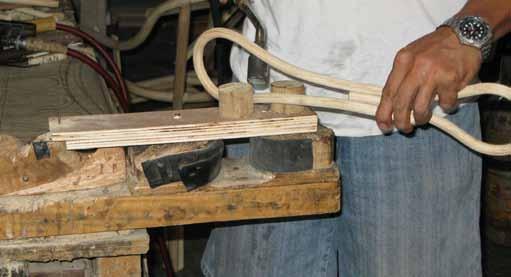
5 minute read
CONCLUSIONS AND RECOMMENDATIONS
5. Conclusions and Recommendations
PLanTaTIon WooD The market for volume plantation species is currently highly competitive at extremely low prices. The recent crisis of the furniture export industry worsens the situation further. Competition with other countries that produce better products employing cheaper and more efficient operations make it very difficult to realize higher prices for the same product quality and processing level. Additionally, the smallholder structure of plantations in Leyte Island makes it difficult to compete even in the domestic market outside Region 8 while the local market in Leyte cannot absorb the total volume of plantation wood available.
Advertisement
To promote the economic well-being of farmers and People’s Organizations whose roles are crucial for sustaining the supply side of the plantation wood value chain, some actions were identified during the workshops for immediate planning and implementation. The goals that the various stakeholders have agreed to pursue to further promote the plantation wood value chain in Leyte are the following: a) Streamline the permitting process; b) Simplify requirements needed for permitting; and c) Install a marketing information system that will make market data accessible to producers (the POs) and the traders and processors.
The farmers, POs, and traders can only advocate that these actions be implemented by government organizations, such as the DENR and DTI. These agencies have the mandate and authority as well as the capacity and resources to address the above action points identified by the plantation wood value chain stakeholders.
As the government agency tasked with the formulation and implementation of policies on natural resource extraction and utilization, DENR has to improve policies and regulations in such a way that they enable proper and sustainable management of these resources. Because the country’s forest resources are vast, DENR alone cannot fulfill the task of protecting them and hence, it needs the support and cooperation of all sectors in carrying out this function. It is reasonable for government to expect people and communities whose lives depend on the forest to share in this task, but because these people are among the poorest of the poor, it is imperative that their economic needs must also be met. Denying these people access to the very resource they help protect and develop is like negating them the opportunity to benefit from their efforts. This is what happens when permits to utilize forest resources are difficult to secure. DENR should take a look at the rules and regulations covering the entire permitting system and their implementation, with the end in view of streamlining them in a manner that would make them consistent with the avowed policy of developing forests with the help of communities.
Closely related to the need for streamlining the permitting system is the simplification of the permit approval process. DENR should rationalize the numerous documents required, and match them with the capacity for compliance by the farmers and the POs. One possible reason for rampant bribe-taking in the sector is the desire of permit applicants to shortcut a very long-winded and complicated process, to avoid getting to line up and to keep returning to DENR offices to obtain signatures of people whose roles
are not clear vis a vis the evaluation of the application for a permit. There is also delay involved in having to wait for the permit to be approved by the central DENR office, with no guarantee that the long wait will result in final approval of the permit. Meanwhile, opportunities for getting a good market price for the timber are missed and valuable time for protecting and developing the forests are lost.
Finally, the plantation wood value chain is also burdened by the lack of updated market information, especially for farmers who have little access to prevailing market prices and trustworthy traders who could make reasonable offers for their products. While the PENRO in Maasin has somewhat succeeded in linking farmers with buyers, the practice is limited in scope and is not yet widespread in Leyte Island. Likewise, there is no assurance that such will be continued when the PENRO leadership is changed. DENR must take steps to ensure that this positive development becomes institutionalized by the agency to ensure its continuity. DTI must also support the value chain in terms of a comprehensive program that will link the plantation wood growers with processors/entrepreneurs who use wood as their raw materials. Markets for forest products should be promoted because an expansion in the demand for finished forest products will result in increasing the demand for plantation wood.
RaTTan anD bamboo Opportunities are available for increasing income, expanding livelihoods, and for generally improving the socio-economic conditions of operators in the rattan and bamboo value chains. These opportunities arise from the ready availability of said forest-based materials and the myriad possibilities in which these can be used, such as for novelty items in the GDH sector. However, as in the plantation wood value chain, stakeholders are not able to get the maximum benefits from their involvement in the chain operation due to the constraints and limitations identified above.
To address these limitations, goals were identified and agreed upon by the stakeholders in the rattan and bamboo value chains. One, it was agreed that the difficulty in complying with documentary requirements, particularly with respect to rattan harvesting, has to be addressed. Strategies and activities were identified to achieve this goal, which could be accomplished by directing efforts towards government and the various agencies that set different requirements for farmers to embark on rattan harvesting operations. Rattan value chain enablers concur with the producers on this goal, as members of this stakeholder group have also found the permitting process to be complex and cumbersome and would therefore need an overhaul.
Another goal identified was to expand the markets for rattan and bamboo products. This would make the sub-sector less vulnerable to fluctuations in the demand for furniture, and at the same time help ensure maximum utilization of rattan and bamboo that are supplied by the producers. This would require diversifying into new product lines and enhancing capacity and skills for developing and designing new products on the part of the processors. The traders and distributors must also aim to intensify their marketing efforts, especially in promoting the new products that would subsequently be developed.
November 2011
Environment and Rural Development Program Deutsche Gesellschaft für Internationale Zusammenarbeit (GIZ) GmbH
2B PDCP Bank Center, V.a. Rufino corner L.P. Leviste Sts. Salcedo Village, makati City, Philippines
Tel. +63 2 892 9051 Fax +62 2 892 3374
www.enrdph.org
Contact Dr. Walter Salzer Director and Principal advisor EnRD Program Email: walter.salzer@giz.de





